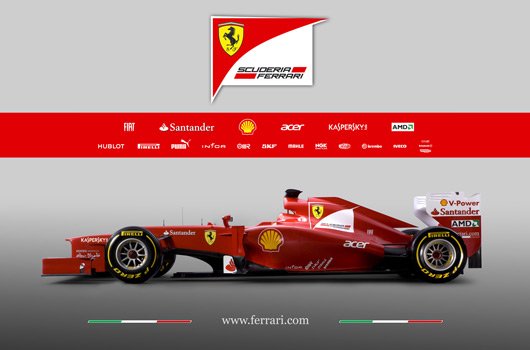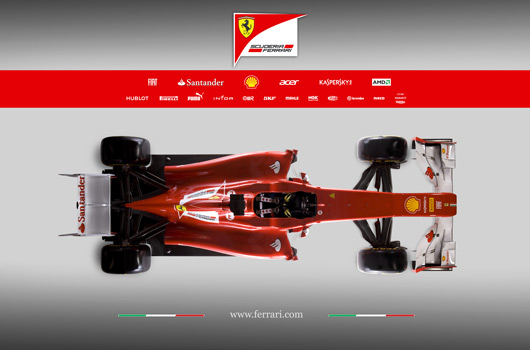Ferrari has just released images of their new F1 car for the upcoming season. This year it’s simply called the F2012, leaving behind the unique F150 naming saga from last season.
Now, that “alligator” nose. It’s not pretty is it. Ferrari acknowledge this too, saying: “The nose has a step in it that is not aesthetically pleasing: with the requirement from the regulations to lower the front part, this was a way of raising the bottom part of the chassis as much as possible for aerodynamic reasons.”
In 2011 Ferrari won just one race, the British Grand Prix. Clearly they have set much higher goals this year and at the launch Fernando Alonso said, “We have to be optimistic. We have to fight for the title.”
Team Principal, Setfano Domenicali, responded by acknowledging Ferrari has an obligation to perform, “That is a sign of the responsibility we feel. We have to offer you [Alonso] a competitive high-performing car. I’m sure it will be winning from the very beginning.”
After the break you can read more from Ferrari as well as seeing a full suite of press images, all available in 2000px super sizing. There’s also a brief video clip showing the F2012 from all angles.
F2012: new single-seater presentation
The F2012 is the fifty eighth car built by Ferrari with the express purpose of taking part in the Formula 1 World Championship. It adopts a well established tradition of being named after its year of manufacture.
The project, which goes by the internal code number of 663, constitutes the Scuderia’s interpretation of the technical and sporting regulations that apply this year: the main changes when compared to 2011 concern the height of the front section of the chassis, the position of the exhaust pipes and the mapping for the electronic engine management. Practically every area of the car has been fundamentally revised, starting with the suspension layout: both the front and rear feature pull-rods, aimed at favouring aerodynamic performance and lowering the centre of gravity. The front wing is derived from the one introduced on the 150º Italia in the final part of its racing life and has been evolved from there. Further evolutions are planned in this area for the opening races of the season. The nose has a step in it that is not aesthetically pleasing: with the requirement from the regulations to lower the front part, this was a way of raising the bottom part of the chassis as much as possible for aerodynamic reasons. The sides have been redesigned, through modifications to the side impact structures, the repositioning of the radiators and revisions to all aerodynamic elements. The lower part of the rear of the car is much narrower and more tapered, a feature achieved partly through a new gearbox casing and a relocation of some mechanical components. In recent years, the area of exhausts has been crucial in terms of car performance and much effort was expended on this front, based on changes to the regulations introduced this year. The rear wing is conceptually similar to the one used in 2011, but every detail of it has been revised and it is now more efficient. Naturally, it is still fitted with DRS (a drag reduction system,) which is operated hydraulically. The front and rear air intakes for the brakes have been redesigned and work was carried out in collaboration with Brembo to optimise the braking system.
The engine in the F2012 is an evolution of the one that powered last year’s car, which is inevitable given that the technical regulations forbid any modification to internal components aimed at increasing performance. Furthermore, much effort has gone into improving its installation in the new chassis, so as not to penalise the aerodynamics of the car. Another area on which the Maranello engine specialists have been working is performance drop off, with the aim of maintaining the highest possible performance level throughout each engine’s cycle of use, which has now reached an average life of three races. The electronic management of the engine has been revised based on the modifications to the rules regarding the use of exhaust gases, a task that has required a great deal of attention and many hours on the test bed. The kinetic energy recovery system maintains its low central location in the car – a choice also aimed at maximising safety – and has undergone an update directed mainly at reducing its weight and at improving the efficiency of some of its components. Several decades of technical collaboration with Shell has seen further progress on the fuel and lubricants front, revolving around improving performance in absolute terms and on durability over the life cycle of the engines, as well as reducing consumption. As usual, great attention has been paid to the electronics on the car, especially in terms of reducing weight and, obviously, reliability.
As always at Ferrari, a great deal of time has been devoted to the performance and optimisation of the materials used, right from the design stage of each of around six thousand components that make up the car. In part, this is done to ensure that all operations carried out at the race track are as efficient and effective as possible. Obviously, quality control remains a crucial aspect, as does the goal of reaching maximum levels of performance and reliability, while maintaining the highest possible safety standards.
With a reduction in the number of days available for track testing before the start of the Championship, which has dropped from fifteen to twelve, preparatory work on the test beds prior to the car’s track debut, has taken on even more importance. The three test sessions – at Jerez de la Frontera and Barcelona – will serve to get a picture of the handling of the F2012 and to adapt it to the Pirelli tyres. Indeed, getting the most out of the tyres has been an area that has seen a lot of work both at the design stage and in how the activities at the track are to be managed. The car is due to undergo a very intensive development programme over the first part of the season, especially on the aerodynamic front.
F2012 technical specifications
Chassis
— Carbon-fibre and honeycomb composite structure
— Ferrari longitudinal gearbox
— Limited-slip differential
— Semiautomatic sequential electronically controlled gearbox – quick shift
— Number of gears: 7 +Reverse
— Brembo ventilated carbon-fibre disc brakes
— Independent suspension, pull-rod activated torsion springs front and rear
— Weight with water, lubricant and driver: 640 kg
— OZ Wheels (front and rear): 13â€
Engine
— Type: 056
— Number of cylinders: 8
— Cylinder block in sand cast aluminium V 90°
— Number of valves: 32
— Pneumatic distribution
— Total displacement: 2398 cm3
— Piston bore: 98 mm
— Weight > 95 kg
— Electronic injection and ignition
— Fuel: Shell V-Power
— Lubricant: Shell Helix Ultra
[530x350px images]








12 replies on “Ferrari unveils 2012 F1 car”
[…] a quick preview comparison of the F2012 against last year’s F150 Italia. We’ll be back later with more side by side […]
Barbara Streisand would be ashamed of that nose.
[…] if the RB8 will follow the alligator/platypus interpretation of the 2012 regulations, as Caterham, Ferrari, Force India and Lotus have […]
[…] Ferrari released their F2012 they said they didn’t mind if their car was ugly so long as it was quick. We’re […]
[…] it’s worth noting the time was set early in the day before a hydraulic problem in the F2012 interrupted his […]
[…] Ferrari F2012 […]
[…] Chassis: F2012 […]
[…] Chassis: F2012 […]
[…] time in Q3 was 1:40.621 and he needed to find every ounce of speed in his Ferrari F2012 to head off the challenge from Red Bull. For a while Michael Schumacher (1:42.459) had his Mercedes […]
[…] Here’s the new Ferrari F138, the car they hope will propel Fernando Alonso to the 2013 world championship. Once you discount this year’s latest fad, the modesty panel hiding the god awful noses we saw last year, then this Ferrari is not terribly different to look at compared with the F2012. […]
[…] Last year’s Ferrari was a bit of a mess. Awful to look at, even by the team’s own admission, and inconsistent on the track. Yet, somehow, Fernando Alonso very nearly won the major prize. So, in 2013, Maranello is hoping for bigger and better things. […]
[…] you compare the McLaren MP4-27 side by side with the Ferrari F2012 you notice something quite interesting. Notice how much lower the nose is on the McLaren? […]